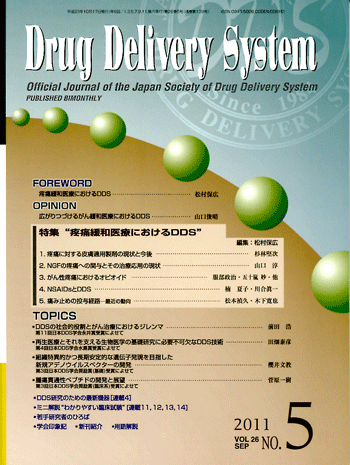All issues

Volume 26 (2011)
- Issue 6 Pages 571-
- Issue 5 Pages 450-
- Issue 4 Pages 366-
- Issue 2 Pages 88-
- Issue 1 Pages 10-
Volume 26, Issue 5
Displaying 1-5 of 5 articles from this issue
- |<
- <
- 1
- >
- >|
Feature articles “DDS in pain relief” Editor : Yasuhiro Matsumura
-
Kenji Sugibayashi2011 Volume 26 Issue 5 Pages 450-456
Published: 2011
Released on J-STAGE: January 17, 2012
JOURNAL FREE ACCESSTopical formulations containing NSAIDs or anesthetics and transdermal delivery systems of(narcotic and non-narcotic)opioid analgesics are presently used for cure and relief of pain in Japan. Second generation of NSAID tape and hydrogel formulations enable direct migration of the drugs into the pain sites under the skin, resulting in typical DDS for the NSAID topical formulations.
Lidocain tape is also applied for the pain relief caused by injection using intravenous indwelling needles, whereas lidocain hydrogel is utilized for pain relief in the postherpetic neuralgia in USA. Transdermal opioid delivery systems are mostly paid attention as the present and future items to be developed. Fentanil and buprenorphine patches are of examples. Combination products with the patches and iontophoresis/microneedles, and transdermal delivery systems containing analgesic additives or adjuvants are future R & D issues for the pain relief.View full abstractDownload PDF (573K) -
Atsushi Yamaguchi2011 Volume 26 Issue 5 Pages 457-460
Published: 2011
Released on J-STAGE: January 17, 2012
JOURNAL FREE ACCESSNGF(Nerve growth factor)is essential for neuronal development, survival and maintenance. NGF plays a critical role in the generation of chronic pain, and its antagonism is expected to be an effective therapy. Recent advances in the research field are summarized in this review.View full abstractDownload PDF (289K) -
Seiji Hattori, Tae Igarashi, Junko Takarada, Hiromi Sano, Tsutomu Oshi ...2011 Volume 26 Issue 5 Pages 461-467
Published: 2011
Released on J-STAGE: January 17, 2012
JOURNAL FREE ACCESSOpioid is golden standard medication for treating cancer pain. Manufacturers had provided many kinds of drug preparation in order to ease cancer pain treatment. Oral, suppository, transdermal and injections. This paper will outline current status of opioid preparation in Japan.View full abstractDownload PDF (1327K) -
Natsuko Kusunoki, Shinichi Kawai2011 Volume 26 Issue 5 Pages 468-475
Published: 2011
Released on J-STAGE: January 17, 2012
JOURNAL FREE ACCESSA lot of topical NSAIDs have been developed to reduce adverse reactions such as gastrointestinal events. Oral selective COX-2 inhibitors are considered as molecular targeting DDS. They could obviously reduce gastrointestinal event, however, incidences of other adverse reactions such as cardiovascular or renal events might not be changed when compared with conventional NSAIDs.View full abstractDownload PDF (865K) -
Yoshihisa Matsumoto, Hiroya Kinoshita2011 Volume 26 Issue 5 Pages 476-479
Published: 2011
Released on J-STAGE: January 17, 2012
JOURNAL FREE ACCESSThe use of analgesics and adjuvant analgesics are often limited because of adverse effects or limited administration routes. The ideal analgesic would be expected to have adequate analgesic effects with minimum adverse events and have multiple administration routes and absorption pathways.View full abstractDownload PDF (269K)
- |<
- <
- 1
- >
- >|